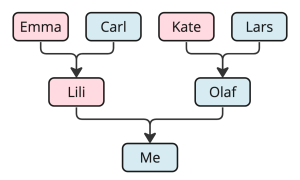Introduction to Data Structures and Algorithms
Data Structures and Algorithms are the backbone of computer science, guiding how we store, organize, and process data. By understanding these concepts, we can make our programs faster, more efficient, and better suited to solve complex problems.
What are Data Structures?
Data structures are ways to organize and store data so it can be used effectively. Depending on what kind of data we have and what we want to do with it, we choose different data structures.
Example: Family Tree
Imagine you want to store information about your family members and how everyone is related. A family tree is a perfect data structure for this because it visually shows how each person is connected, making it easy to trace relationships, like finding your grandmother’s name quickly.
Importance of Data Structures
In the digital world, data structures help manage large amounts of information efficiently. They are crucial for things like databases, search engines, and even social networks. With the right data structure, you can store, retrieve, and manipulate data quickly and easily.
Types of Data Structures
- Primitive Data Structures: Basic types provided by programming languages like integers, floats, characters, and booleans.
- Abstract Data Structures: More complex structures built from primitive types, like arrays, linked lists, stacks, queues, trees, and graphs.
What are Algorithms?
Algorithms are step-by-step instructions to solve a problem or achieve a goal. They are like recipes that tell the computer exactly what to do with the data stored in structures.
Example: Recipe
Think of an algorithm as a cooking recipe. If you follow each step, you’ll end up with a delicious meal. In computer science, the “ingredients” are data structures, and the “recipe” is the algorithm.
Why Algorithms Matter
Algorithms are essential because they make programs work efficiently. A well-designed algorithm can turn a slow program into a fast one by finding the best solution to a problem.
Common Algorithms
- Search Algorithms: Find information in a data structure.
- Sorting Algorithms: Organize data, like sorting a list of names.
- Graph Algorithms: Find the shortest path between two points, like in GPS navigation.
Data Structures and Algorithms: A Powerful Combination
Data structures and algorithms work together to create efficient programs. The right data structure makes it easier for an algorithm to solve a problem quickly. For example, the “Bubble Sort” algorithm sorts data in an array structure.
Where Are Data Structures and Algorithms Used?
Data structures and algorithms are used everywhere in software:
- Operating Systems: Manage files and memory.
- Web Applications: Handle large amounts of user data.
- Machine Learning: Process and analyze data.
- Video Games: Control game mechanics and AI.
- Cryptography: Secure data and communications.
Learning Data Structures and Algorithms
- Start with a programming language like Python.
- Learn about computational complexity (e.g., Big O notation).
- Practice by solving problems and building projects.
Differences Between Data Structures and Algorithms
| Aspect | Data Structures | Algorithms |
|---|---|---|
| Definition | How data is organized and stored | Step-by-step instructions to solve a problem |
| Purpose | Efficiently organize and store data | Systematically solve problems |
| Operations | Insertion, Deletion, Search, Update, Traverse | Sorting, Searching, Optimization, Pathfinding |
| Importance | Critical for data management | Crucial for program efficiency |
| Relationship | Provide a framework for data that algorithms operate on | Operate on data structures to process or manipulate data |
| Performance | Affects algorithm efficiency | Affects program performance |
| Examples | Array, Linked List, Stack, Queue, Tree, Graph, etc. | Sorting, Searching, Graph Traversal, etc. |
Conclusion
Understanding data structures and algorithms is essential for anyone looking to develop high-performance software. They work hand-in-hand to solve problems, manage data, and create efficient and effective programs. Whether you’re managing a large database or building a search engine, mastering these concepts is key to success. For more details about this topic visit the Development to techcyb.com.

